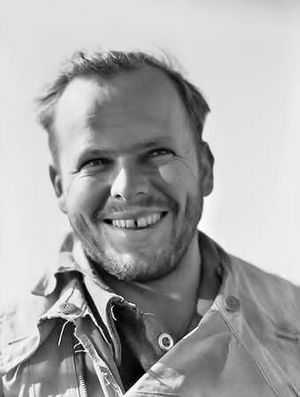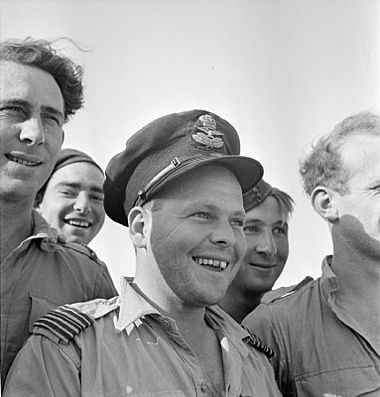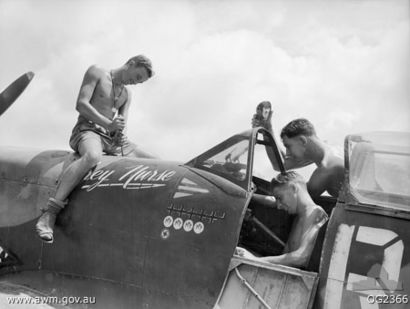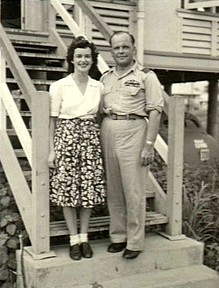Bobby Gibbes facts for kids
Quick facts for kids
Bobby Gibbes
|
|
|---|---|

Bobby Gibbes, North Africa, c. January 1942
|
|
| Birth name | Robert Henry Maxwell Gibbes |
| Born | 6 May 1916 Young, New South Wales |
| Died | 11 April 2007 (aged 90) Sydney, New South Wales |
| Allegiance | Australia |
| Service/ |
Royal Australian Air Force |
| Years of service | 1940–1946 1952–1957 |
| Rank | Wing Commander |
| Unit | No. 23 Squadron (1940) No. 450 Squadron (1941) No. 2 OTU (1944) No. 80 Wing (1944–1945) |
| Commands held | No. 3 Squadron (1942–1943) |
| Battles/wars | World War II
|
| Awards | Distinguished Service Order Distinguished Flying Cross and Bar Medal of the Order of Australia |
| Other work | Businessman |
Robert Henry Maxwell Gibbes (6 May 1916 – 11 April 2007), known as Bobby, was a brave Australian pilot during World War II. He was a "fighter ace", which means he shot down many enemy planes. He was also the longest-serving leader of No. 3 Squadron RAAF during the war. Bobby Gibbes was officially credited with taking down 10¼ enemy aircraft. Some reports say he took down 12. He also probably destroyed five more planes and damaged 16 others.
Bobby Gibbes led No. 3 Squadron in North Africa from February 1942 to April 1943. He was briefly wounded during this time. For his great leadership and fighting skills, he received important awards. These included the Distinguished Service Order and the Distinguished Flying Cross and Bar. After his time in North Africa, he served in the South West Pacific. He was part of a group of pilots who protested about missions they felt were pointless. After the war, he spent many years in New Guinea. He helped build local businesses there. For this work, he received the Medal of the Order of Australia in 2004. He loved flying and continued to fly planes until he was 85 years old.
Contents
Early Life and Joining the Air Force
Bobby Gibbes was born on 6 May 1916 in Young, New South Wales. He was the only son of Henry and Cora Gibbes. His family had a long history of serving in government and the military. His great-grandfather built a famous house in Sydney. His grandfather owned a property that later became the official home of Australia's Governor-General. Bobby's father was a farmer. His uncle was a pilot in World War I who sadly died in battle.
Bobby went to schools in Bathurst and Manly. Before joining the military, he worked as a "jackaroo". A jackaroo is a young man learning to work on a large farm in Australia. He also worked as a salesman.
Bobby joined the Royal Australian Air Force (RAAF) on 2 February 1940. He really wanted to join, so he made himself seem taller than he was! He had already paid for some flying lessons. He joked that he waited for the King to pay for the rest once the war started. After training, he became a pilot officer in June 1940. His first job was with No. 23 Squadron RAAF in Queensland. He was promoted to flying officer in December 1940.
Two of Bobby's cousins were also RAAF pilots. Rodney Gibbes joined in 1936. Peter Gibbes was an airline pilot before the war and joined in 1940. Both cousins also earned the Distinguished Flying Cross for their bravery. Sadly, Rodney died in action in 1943.
Fighting in World War II
Middle East Battles
In April 1941, Bobby Gibbes was sent to the Middle East. He joined No. 3 Squadron RAAF in May. The squadron flew Hawker Hurricane planes at first. Then they switched to P-40 Tomahawks. In June, they started fighting in the Syria–Lebanon Campaign. On 13 June, Bobby probably destroyed a German Junkers Ju 88 plane. On 11 July, he got his first confirmed "kill". This was a French Dewoitine D.520 fighter plane. He shared this victory with another pilot, John Jackson. They flipped a coin to see who would get full credit, and Bobby won!
In September, No. 3 Squadron moved to the Western Desert Campaign. Here, they fought against German and Italian forces. On 20 November, Bobby helped destroy a German Messerschmitt Bf 110. His own plane was damaged, and he had to crash-land. Five days later, he shot down two Italian Fiat G.50 planes. He also damaged three more, plus a German Messerschmitt Bf 109. On 30 November, he destroyed another G.50. In January 1942, he shot down a Junkers Ju 87 and damaged two G.50s. He was promoted to acting flight lieutenant that month.
Bobby Gibbes became the leader of No. 3 Squadron on 26 February 1942. The squadron's planes were now Kittyhawks. Bobby painted a funny cartoon on his plane. It showed a kangaroo kicking a dachshund dog! On 7 May, he claimed a German Bf 109. On 26 May, he was shot down while attacking German bombers. He had to bail out of his plane using a parachute. Part of his parachute got stuck, and he struggled to get free. He broke his ankle when he landed. But he was flying again within six weeks, even with his leg still in a cast!
Because of his injury, another pilot, Nicky Barr, led the squadron for a short time. Nicky Barr later said that Bobby Gibbes wasn't the best shot. But he had amazing eyesight and could always spot enemy planes first. Another pilot, Tom Russell, agreed. He said Bobby was great at finding targets and getting the squadron back into formation quickly.
Bobby Gibbes received the Distinguished Flying Cross (DFC) on 28 July 1942. This award was for his "exceptional skill and gallantry" on 26 May. On 1 September, he destroyed a Bf 109 and damaged two others. This was during the Battle of Alam el Halfa. On 28 October, he claimed No. 3 Squadron's 200th enemy plane during the Second Battle of El Alamein.
On 21 December, Bobby showed incredible bravery. He landed his Kittyhawk in a rough area in Libya to rescue a fellow pilot who had crashed. Bobby threw out his own parachute to make space for the other pilot in the cockpit. He damaged his plane's landing gear when taking off. This meant he had to land back at base on one wheel! He was recommended for the Victoria Cross, which is a very high award. Instead, he received the Distinguished Service Order on 15 January 1943. This award was for his "outstanding qualities of leadership and enthusiasm".
Bobby crashed behind enemy lines again on 14 January 1943. He walked about 50 miles (80 km) through the desert before a British Army patrol found him. For this amazing feat and his leadership, he received a "bar" to his DFC. This meant he got the DFC a second time. This made him the most highly decorated pilot in the RAAF at that time.
On 22 January 1943, Bobby claimed his last enemy plane, an Italian C.202. He was officially credited with 10¼ victories. He also had 5 "probables" and damaged 16 other planes. He flew 274 missions in the Middle East. He was No. 3 Squadron's longest-serving wartime leader.
South West Pacific Missions
Bobby Gibbes left command of No. 3 Squadron on 19 April 1943. He was promoted to squadron leader. He then worked in London for a while. He learned to fly de Havilland Mosquito night fighters. He was then sent back to Australia. In January 1944, he became a chief flying instructor at No. 2 Operational Conversion Unit RAAF. He worked with Clive Caldwell, Australia's top pilot, to train new pilots. Bobby was promoted to temporary wing commander on 1 July.
In October, he moved to Darwin. He flew Supermarine Spitfires as a "wing leader" for No. 80 Wing RAAF. This meant he was second-in-command to Group Captain Caldwell. Bobby later suffered burns in a crash landing after his engine failed. In December, he met Jeannine Ince, a Red Cross volunteer who nursed him in hospital. They married on 23 January 1945.
No. 80 Wing moved to the Dutch East Indies in early 1945. Bobby joined them on Morotai in March. He temporarily took over as leader when Caldwell was away. In April, Bobby was one of eight senior pilots who tried to resign. They were protesting because the RAAF fighter squadrons were being given missions that seemed useless. This event became known as the "Morotai Mutiny". Bobby said he lost his enthusiasm for the service because the missions felt pointless. He especially hated one mission where they had to attack cattle. He said it felt like "butchering". A government inquiry later found that the pilots' protest was fair.
After the War
Bobby Gibbes left the Air Force on 11 January 1946. He first worked as a stock and station agent in Coonamble, New South Wales. He even flew his own twin-engined plane for work!
He then spent about 30 years in New Guinea. He helped start businesses there in transport, coffee, and hotels. In 1948, he started Gibbes Sepik Airways. He used some interesting planes, including three German Junkers Ju 52s. One of these was said to have been used by a German air force commander. His friend Nicky Barr briefly joined him in this business.
Bobby also started a coffee plantation in New Guinea in 1950. He was part of the RAAF Active Reserve from 1952 to 1957. In 1958, he sold his airline business. He continued to develop coffee plantations and built a large chain of hotels.
Bobby sold his businesses in New Guinea in 1972. He then spent many years sailing his catamaran boat, Billabong, around the Mediterranean. When he was in his 60s, he sailed Billabong by himself from England to Australia. He faced big storms and even pirates!
By 1979, he was living in Sydney. He started building his own twin-engined plane, which he flew in 1990. In 1994, Bobby wrote his life story called You Live But Once. He kept flying until he had to give up his pilot's license at age 85. In 2002, he was featured in a TV show about Nicky Barr.
Bobby Gibbes received the Medal of the Order of Australia on 26 January 2004. This was for his service to aviation and tourism, especially in Papua New Guinea. He passed away from a stroke in Sydney on 11 April 2007, at the age of 90. He was survived by his wife and two daughters. Many people attended his funeral, including the head of the Australian Air Force. A Spitfire plane, painted like one of Bobby's World War II aircraft, flew over the church. Four F/A-18 Hornet jet fighters from No. 3 Squadron also flew in a special "missing man" formation to honor him.
Images for kids
See also
 In Spanish: Bobby Gibbes para niños
In Spanish: Bobby Gibbes para niños










